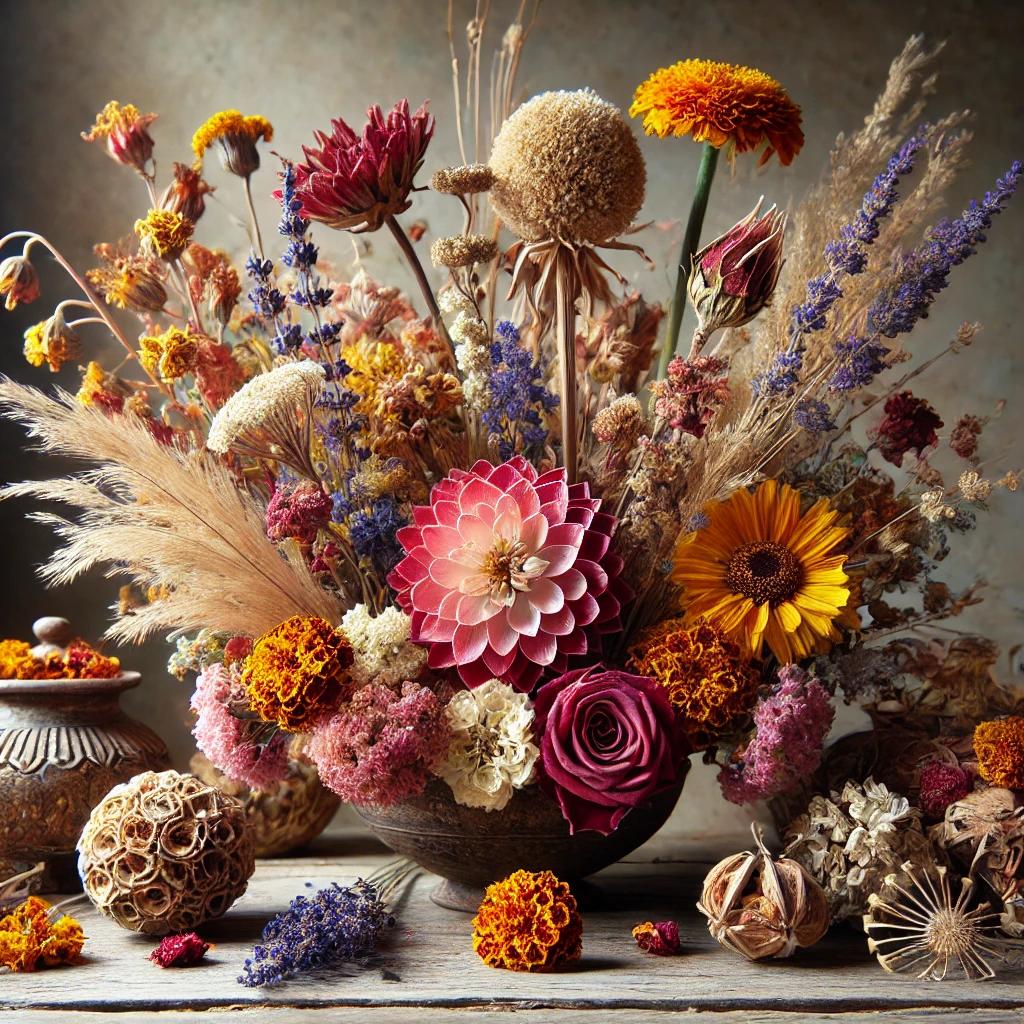Cultural Significance of Dried Flowers Around the World
Posted by : admin004 | On : November 7, 2024
An enduring allure has been held by dried flowers across cultures, celebrated for their beauty, symbolism, and resilience. Their use stretches back centuries and remains relevant today, bringing with them layers of meaning that resonate deeply in diverse traditions worldwide. From the Japanese art of Ikebana to Mexican rituals, the cultural significance of dried flowers is profound, enriching everything from personal rituals to grand ceremonies. Let’s take a journey around the world to understand how different cultures have embraced and honored dried flowers for their unique and lasting appeal.
1. Japan: Dried Flowers in Ikebana and Hanakotoba
In Japan, the traditional art of Ikebana, or flower arranging, goes beyond the use of fresh flowers, incorporating dried flowers to represent the natural cycle of life and the beauty of impermanence. Each flower has a specific meaning in the Japanese “language of flowers,” known as hanakotoba, where the cultural significance of dried flowers is deeply appreciated. Dried cherry blossoms, for instance, symbolize life’s fleeting beauty, while chrysanthemums represent purity and are used in memorial practices. Through the use of dried flowers, Japanese culture honors life’s transient nature and cherishes each phase of existence.
2. India: Dried Flowers in Rituals and Ayurveda
India’s cultural significance of dried flowers is apparent in both religious ceremonies and Ayurveda. Marigolds, roses, and jasmine flowers are commonly dried and used in Hindu ceremonies to convey blessings and devotion. Dried marigolds, in particular, symbolize endurance and are used as offerings in weddings and temples, reinforcing the values of commitment and prosperity. Additionally, Ayurveda, India’s ancient wellness practice, relies on dried flowers for their therapeutic properties. For example, dried rose petals are used to create calming oils and teas, showcasing how dried flowers support both spiritual and physical well-being in Indian culture.
3. China: Dried Flowers in Medicine and Feng Shui
The cultural significance of dried flowers in China extends to both traditional medicine and feng shui, where flowers such as lotus and chrysanthemum are widely valued. Dried chrysanthemum tea is believed to help balance the body and cool it, serving as a centuries-old remedy for ailments related to the liver and eyes. In feng shui, dried flowers like lavender and peonies are displayed in homes to create a peaceful environment and attract prosperity. By using dried flowers, Chinese culture emphasizes the importance of harmony, health, and positivity in everyday life.
4. Europe: Dried Flowers in Victorian Language of Flowers
During the Victorian era in Europe, the cultural significance of dried flowers was expressed through floriography, or the “language of flowers.” Here, flowers were assigned meanings and used to communicate sentiments that might otherwise go unspoken. Dried roses symbolized enduring love, while lavender stood for devotion. Many Victorians would dry and preserve flowers in keepsake books and letters to cherish personal memories. Today, dried flowers are still popular in European decor for their rustic charm, eco-friendliness, and historical significance, offering a bridge to the sentiments of past eras.
5. Middle East: Fragrance and Spiritual Connection through Dried Flowers
In Middle Eastern traditions, the cultural significance of dried flowers is tied to both fragrance and spirituality. Dried roses and jasmine flowers are prominent in religious practices and are often used in teas, perfumes, and ceremonial incense. For instance, the scent of dried rose petals is believed to cleanse the soul and is used in worship rituals. Dried flowers, especially roses and lavender, are key ingredients in oud and incense. They emphasizing the Middle Eastern appreciation for creating fragrant, spiritually meaningful environments that promote peace and reverence.
6. Mexico: Marigolds and Día de los Muertos
In Mexico, dried marigolds, or cempasuchil, hold immense cultural significance during Día de los Muertos (Day of the Dead). This flower is believed to guide the spirits of departed loved ones back to the world of the living, helping families reconnect with their ancestors. The dried marigold’s distinct fragrance is thought to attract spirits, and families use the flower to create vibrant displays on altars and grave sites. In Mexican culture, dried flowers—especially marigolds—represent the bridge between life and death, celebrating ancestry with deep respect and affection.
Modern Revival of Dried Flowers
Today, the cultural significance of dried flowers continues to resonate as dried flower arrangements are embraced for their eco-friendly and long-lasting qualities. From wedding bouquets to home décor, dried flowers are appreciated for their timeless beauty and sustainability. This global revival shows how dried flowers have adapted to modern tastes while honoring their cultural roots. Each dried flower carries with it a piece of history and a reflection of values like resilience, love, and remembrance.
Conclusion
The cultural significance of dried flowers is a testament to their beauty, versatility, and symbolic depth. Whether in the delicate arrangements of Ikebana, the herbal remedies of Ayurveda, or the vibrant displays of Día de los Muertos, dried flowers remind us of the common threads that connect humanity across generations and continents. Through dried flowers, cultures worldwide celebrate nature, cherish memories, and embrace the power of enduring beauty. Dried Flowers bring with them the timeless traditions and meanings that have inspired people for centuries.
